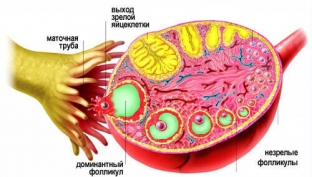It's hard to believe, but at the moment, about 300 million girls and women in the world are experiencing their period. The monthly menstrual cycle, the final stage of which is menstruation, is an inevitable reality that most women face. The period of menstruation lasts approximately 2-7 days and repeats on average every 28 days (normally the menstrual cycle lasts 21-35 days). But why is this cycle so versatile and what exactly happens during your period?
What happens in the female body during menstruation?
Behind the cyclic changes are menstrual-regulating hormones that precisely coordinate the internal mechanisms that start or stop menstruation in the aforementioned 28-day span:
- follicle stimulating hormone;
- estrogen;
- luteinizing hormone;
- progesterone.
This internal mechanism involves 2 ovaries, which contain thousands of follicles containing one oocyte each - an immature egg. It is surrounded by epithelial cells and two layers of connective tissue.
See also: The menstrual cycle: how do hormone levels change?
At puberty, the ovaries contain over 400,000 immature eggs, of which only one is released per month. After the maturation and release of the egg from the follicle, there are two scenarios:
- pregnancy;
- menstruation.
This is what happens during your period:
Every month, the pituitary gland - a hormone-secreting gland located at the base of the brain - produces 2 hormones: follicle-stimulating and luteinizing. When these hormones travel through the bloodstream to the ovaries, they stimulate the growth and maturation of the eggs contained in the follicles. In turn, the follicles respond to this by producing estrogen. Eggs grow and estrogen levels rise in the meantime, reaching a maximum level, suppressing the production of follicle-stimulating hormone and stimulating the production of luteinizing hormone in the pituitary gland.
Menarche and menopause are the first and, accordingly, the last menstruation in life.
As a result, only the most mature egg in one of the ovaries comes out of the burst follicle and through the fallopian tube connecting the ovary to the uterus. This period is called ovulation. This stage takes place 10-16 days before the onset of menstruation. Due to the slow contractions of the muscular tissue of the fallopian tube, the egg, ready for fertilization, moves towards the uterus. This fascinating journey of the egg through the fallopian tube takes about 4 days. However, estet-portal.com considers it important to mention that fertilization must occur within the first 24 hours after the release of the egg, otherwise the woman will have a period of menstruation.

The duration of the ovulation period is 24 hours.
Meanwhile, having released the egg, the follicle, under the influence of luteinizing hormone, is transformed into a corpus luteum. The corpus luteum is a temporary gland that secretes the hormone progesterone. Progesterone causes the uterine lining to grow and thicken, while there is also an influx of blood and nutrients to the future site of attachment and development of a fertilized egg. Thus, the female body prepares the environment for the growth and development of the unborn baby.
During menstruation, an unfertilized egg and endometrium, previously prepared for the attachment and development of a fertilized egg, as well as the secretion of the glands of the vagina and uterus, comes out with the blood.
If, as mentioned above, fertilization has not occurred, progesterone and estrogen levels begin to decline. Accordingly, the prepared “nest” for the unborn child begins to collapse, i.e. rejection of the pre-extended mucosa begins. Actually, this is exactly what happens during menstruation - the exit from the vagina of the dead endometrium and, of course, the unfertilized egg. More specifically, menstrual flow contains:
- menstrual blood;
- endometrium (dead mucous membrane);
- cervical gland secretion;
- Secret of the glands of the vagina.
It may take 2 to 7 days for the uterus to get rid of all unnecessary things.
After that, the cycle starts again. Hormones constantly control processes before, during and after menstruation, circulating in optimal quantities. They are at the right time and in the right place.






Add a comment